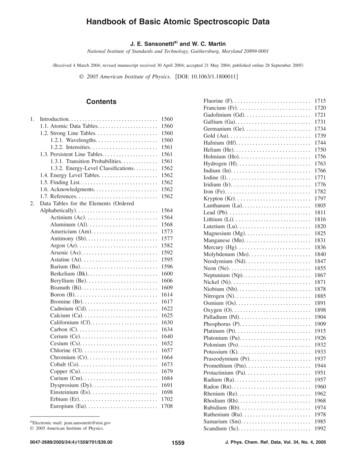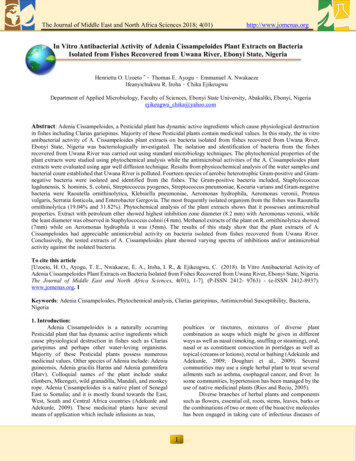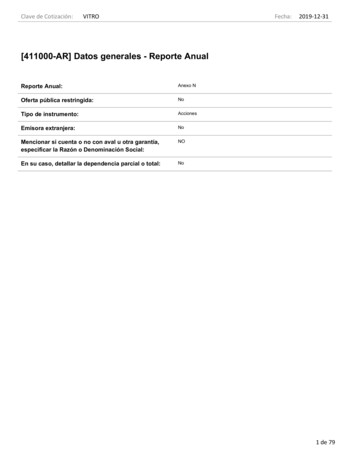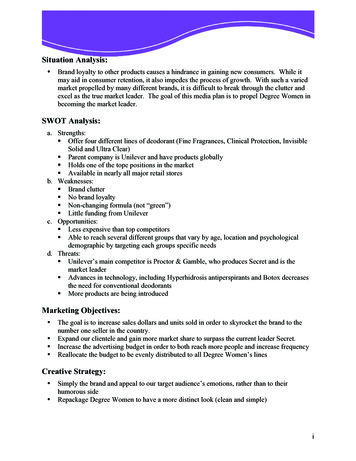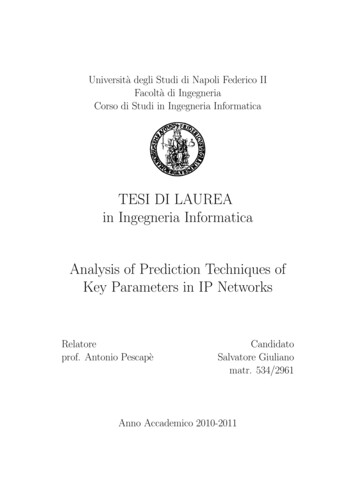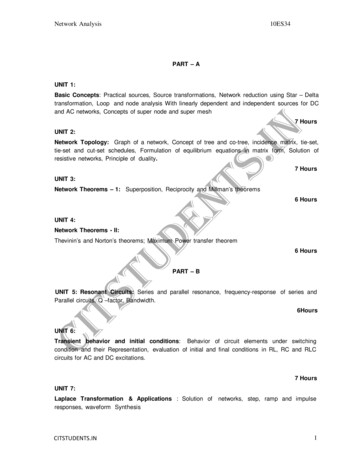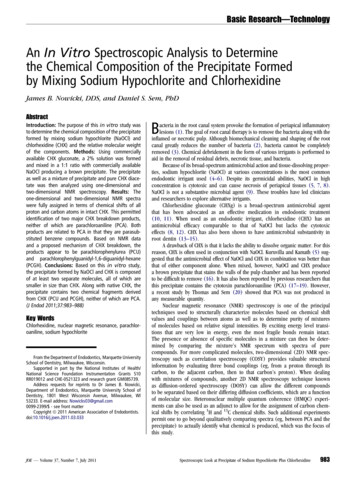
Transcription
Basic Research—TechnologyAn In Vitro Spectroscopic Analysis to Determinethe Chemical Composition of the Precipitate Formedby Mixing Sodium Hypochlorite and ChlorhexidineJames B. Nowicki, DDS, and Daniel S. Sem, PhDAbstractIntroduction: The purpose of this in vitro study wasto determine the chemical composition of the precipitateformed by mixing sodium hypochlorite (NaOCl) andchlorhexidine (CHX) and the relative molecular weightof the components. Methods: Using commerciallyavailable CHX gluconate, a 2% solution was formedand mixed in a 1:1 ratio with commercially availableNaOCl producing a brown precipitate. The precipitateas well as a mixture of precipitate and pure CHX diacetate was then analyzed using one-dimensional andtwo-dimensional NMR spectroscopy. Results: Theone-dimensional and two-dimensional NMR spectrawere fully assigned in terms of chemical shifts of allproton and carbon atoms in intact CHX. This permittedidentification of two major CHX breakdown products,neither of which are parachloroaniline (PCA). Bothproducts are related to PCA in that they are parasubstituted benzene compounds. Based on NMR dataand a proposed mechanism of CHX breakdown, theproducts appear to be parachlorophenylurea (PCU)and H). Conclusions: Based on this in vitro study,the precipitate formed by NaOCl and CHX is composedof at least two separate molecules, all of which aresmaller in size than CHX. Along with native CHX, theprecipitate contains two chemical fragments derivedfrom CHX (PCU and PCGH), neither of which are PCA.(J Endod 2011;37:983–988)Key WordsChlorhexidine, nuclear magnetic resonance, parachloroaniline, sodium hypochloriteFrom the Department of Endodontics, Marquette UniversitySchool of Dentistry, Milwaukee, Wisconsin.Supported in part by the National Institutes of Health/National Science Foundation Instrumentation Grants S10RR019012 and CHE-0521323 and research grant GM085739.Address requests for reprints to Dr James B. Nowicki,Department of Endodontics, Marquette University School ofDentistry, 1801 West Wisconsin Avenue, Milwaukee, WI53233. E-mail address: Nowicks03@gmail.com0099-2399/ - see front matterCopyright ª 2011 American Association of Endodontists.doi:10.1016/j.joen.2011.03.033JOE — Volume 37, Number 7, July 2011Bacteria in the root canal system provoke the formation of periapical inflammatorylesions (1). The goal of root canal therapy is to remove the bacteria along with theinflamed or necrotic pulp. Although biomechanical cleaning and shaping of the rootcanal greatly reduces the number of bacteria (2), bacteria cannot be completelyremoved (3). Chemical debridement in the form of various irrigants is performed toaid in the removal of residual debris, necrotic tissue, and bacteria.Because of its broad-spectrum antimicrobial action and tissue-dissolving properties, sodium hypochlorite (NaOCl) at various concentrations is the most commonendodontic irrigant used (4–6). Despite its germicidal abilities, NaOCl in highconcentration is cytotoxic and can cause necrosis of periapical tissues (5, 7, 8).NaOCl is not a substantive microbial agent (9). These troubles have led cliniciansand researchers to explore alternative irrigants.Chlorhexidine gluconate (CHXg) is a broad-spectrum antimicrobial agentthat has been advocated as an effective medication in endodontic treatment(10, 11). When used as an endodontic irrigant, chlorhexidine (CHX) has anantimicrobial efficacy comparable to that of NaOCl but lacks the cytotoxiceffects (8, 12). CHX has also been shown to have antimicrobial substantivity inroot dentin (13–15).A drawback of CHX is that it lacks the ability to dissolve organic matter. For thisreason, CHX is often used in conjunction with NaOCl. Kuruvilla and Kamath (5) suggested that the antimicrobial effect of NaOCl and CHX in combination was better thanthat of either component alone. When mixed, however, NaOCl and CHX producea brown precipitate that stains the walls of the pulp chamber and has been reportedto be difficult to remove (16). It has also been reported by previous researchers thatthis precipitate contains the cytotoxin parachloroaniline (PCA) (17–19). However,a recent study by Thomas and Sem (20) showed that PCA was not produced inany measurable quantity.Nuclear magnetic resonance (NMR) spectroscopy is one of the principaltechniques used to structurally characterize molecules based on chemical shiftvalues and couplings between atoms as well as to determine purity of mixturesof molecules based on relative signal intensities. By exciting energy level transitions that are very low in energy, even the most fragile bonds remain intact.The presence or absence of specific molecules in a mixture can then be determined by comparing the mixture’s NMR spectrum with spectra of purecompounds. For more complicated molecules, two-dimensional (2D) NMR spectroscopy such as correlation spectroscopy (COSY) provides valuable structuralinformation by evaluating three bond couplings (eg, from a proton through itscarbon, to the adjacent carbon, then to that carbon’s proton). When dealingwith mixtures of compounds, another 2D NMR spectroscopy technique knownas diffusion-ordered spectroscopy (DOSY) can allow the different compoundsto be separated based on their differing diffusion coefficients, which are a functionof molecular size. Heteronuclear multiple quantum coherence (HMQC) experiments can also be used as an adjunct to allow for the assignment of carbon chemical shifts by correlating 1H and 13C chemical shifts. Such additional experimentspermit one to go beyond qualitatively comparing spectra (eg, between PCA and theprecipitate) to actually identify what chemical is produced, which was the focus ofthis study.Spectroscopic Look at Precipitate of Sodium Hypochlorite Plus Chlorhexidine983
Basic Research—TechnologyFigure 1. NMR spectra for pure CHX diacetate. (A) 1H NMR spectrum of CHX, with protons assigned according to the numbering scheme shown on the chemicalstructure of CHX (in the insert). (B) 2D 1H-1H COSY spectrum showing cross peaks that were used to make the assignments for proton pairs (1/2) and (3/4)according to the numbering scheme used in panel A. (C) 1D 13C NMR spectrum of CHX with carbon assignments based on 1H-13C HMQC spectra. (D) 2D DOSYspectrum showing that only one species is present and diffusing with a diffusion coefficient of 0.5 10 10 m2/s.984Nowicki and Semhttp://endodontic.ws/JOE — Volume 37, Number 7, July 2011
Basic Research—TechnologyAlthough there has been much speculation as to whether PCAis or is not present in the precipitate formed by CHX and NaOCl, todate the composition of the precipitate has not been completelycharacterized. The purpose of this in vitro study was to determinethe chemical composition of the precipitate formed by NaOCl andCHX.Materials and MethodsA commercially available sample of CHXg (Sigma-Aldrich, St Louis,MO) was analyzed with 1H NMR spectroscopy (400-MHz Varian NMRSystem acquiring 32 scans/spectrum) with perdeuterated dimethyl sulfoxide (d6-DMSO) as a solvent.A 2% aqueous solution of CHXg was prepared by mixing 2.5 mL20% CHXg with 22.5 mL deionized H2O. This solution was warmed to37 C and mixed with 25 mL of 5.25% NaOCl and stirred continuously.The brown precipitate formed immediately. Two 1.5-mL samples weretaken and placed in 1.5-mL microfuge tubes and centrifuged at 14,000rpm for 2.5 minutes. The precipitate solid was removed and dissolved in1.0 mL of d6-DMSO; 100 mL of 0.5 g/mL pure CHX diacetate (CHXa)dissolved in d6-DMSO was added to one sample. One-dimensional(1H, 13C) and 2D (COSY, DOSY, and HMQC) NMR spectra were thencollected for each of the samples at 25 C. Resulting spectra were fullyassigned in terms of chemical shifts of all proton and carbon atoms inintact CHX, which permitted the identification of CHX breakdown products.ResultsBefore the analysis of CHX breakdown products can be undertaken, full NMR characterization of pure CHX (as the acetate salt)was performed as summarized in Figure 1. A prominent COSY crosspeak in Figure 1B establishes the connection between the deshieldedN-attached CH2 linker protons (3, at 3.08 ppm) and the adjacentCH2 protons in position 4 (1.43 ppm). This leaves the –CH2 protonsat position 5 as assigned to the most up-field resonance at 1.24 ppm.These proton chemical shift assignments allow assignment of all chemical shifts in the 1D 13C spectrum (Fig. 1C) based on the 2D 1H-13CHMQC spectrum (not shown). The DOSY spectrum in Figure 1D showsall expected peaks for protons 1 through 5 for a molecule diffusing witha diffusion coefficient of 0.5 10 10 m2/s.CHX was then treated with NaOCl to form a precipitate, and thatprecipitate (dissolved in DMSO) was analyzed using DOSY spectra.There are two products (ignoring solvent and gluconate signals),both of which are lower in molecular weight than the original CHXbecause they have larger diffusion coefficients of around 1 to 2.5 10 10 m2/sec (Fig. 2B). These breakdown products have aromaticsignals around 7 to 8 ppm, and one also has protons with chemicalshifts of 4 ppm and 2.5 ppm. These chemical shifts are consistentwith at least one of the breakdown products still possessing the aliphaticlinker (ie, chlorophenylguanidyl-1,6-diguanidyl-hexane [PCGH]). Theother breakdown product seems to be lacking the aliphatic protons,which is consistent with the linker being absent (ie, parachlorophenylurea [PCU]). The DOSY spectrum also shows the three characteristicNMR resonances for undegraded CHX at the top of Figure 2B. Toconfirm that these signals are in fact from undegraded CHX, pureCHX was spiked into the sample. The resulting DOSY spectrum(Fig. 2D) shows an increase in intensity for these signals, consistentwith them having been from residual undegraded CHX.In a repeat of the CHX NaOCl experiment (using CHXg), theCOSY spectrum of the precipitate (Fig. 3A) shows two amides fromthe guanido with connectivity to the linker CH2- (and a third minorspecies). There are two major species present, each with a linker, basedJOE — Volume 37, Number 7, July 2011Figure 2. NMR spectra for precipitate after treating CHX with NaOCl and thendissolving in DMSO. (A) 1D 1H NMR spectrum and (B) 2D DOSY spectrum.The sample in panels A and B was spiked with undegraded CHXa, and (C)1D 1H NMR and (D) 2D DOSY spectra were again collected.on the observation of cross peaks with N-H chemical shifts, with connectivity to C-H chemical shifts. The corresponding HMQC spectrum(Fig. 3B) confirms there are 2 different parasubstituted benzenesystems present (PCGH and PCU). Interestingly, the DOSY spectrumindicates that the two aromatic signals around 7.4 ppm are from undegraded CHX, whereas the pair around 7 ppm are from a fast diffusingSpectroscopic Look at Precipitate of Sodium Hypochlorite Plus Chlorhexidinehttp://endodontic.ws/985
Basic Research—TechnologyFigure 3. (A) COSY spectrum of CHX precipitate (after treatment with NaOCl) and then dissolving in DMSO. The three cross peaks at 7 to 8 ppm indicate there arethree different chemical species present that have a guanido N-H that is chemically attached to a linker carbon (which has a chemical shift of 3.0). (B) HMQCspectrum of CHX precipitate (after treatment with NaOCl) and then dissolving in DMSO. In comparing the spectrum in A, note that HMQC spectra do not showN-attached protons; only C-H connectivities are observed. The two pairs of cross peaks at 7.0 and 7.5 ppm indicated there are two different substituted benzenespecies present. The lack of a COSY cross peak at 7.0/7.5 ppm (A) suggests that the pair at 7.0 is for one chemical species and the pair at 7.5 ppm is for the other.(C) The proposed mechanism for base-catalyzed cleavage of CHX showing tetrahedral intermediate (1) and breakdown products as PCGH (2) and PCU (3).986Nowicki and Semhttp://endodontic.ws/JOE — Volume 37, Number 7, July 2011
Basic Research—Technologyspecies (low molecular weight) that lacks any linker protons but haschemical shifts distinct from parachloroaniline (assigned to be PCU).The COSY and HMQC spectra (Fig. 3) are also consistent with the crosspeaks at 7.4 being from one of the substituted benzenes, with those at7.0 ppm being from another substituted benzene species.The NMR spectral analysis clearly indicates that there are twobreakdown products that are parachlorosubstituted benzenes but arenot PCA. Based on the analysis and a reasonable chemical mechanismfor the breakdown of CHX (Fig. 3C), chemical structures for the breakdown products can best be represented by the structures shown inFigure 3C referred to as PCU and PCGH.DiscussionPrevious studies examining the precipitate formed by mixing CHXand NaOCl have focused on whether the toxin PCA is produced. Basraniet al (17, 21) argued that PCA was in fact a component of the precipitate,based on mass spectrometry data. However, Thomas and Sem (20) didnot observe PCA using an alternative technique, NMR. Thomas and Semhad argued that mass spectrometry might not be a reliable method fordetermining the presence of degradation products because it relies ongas phase ionization, which can fragment molecules. In contrast, NMRspectroscopy analyzes molecules in a noninvasive and nondestructivemanner.Krishnamurthy and Sundhakaran (18) reported that PCA waspresent based on Beilstein and HCl solubility tests along with NMR spectroscopy, but those tests do not identify exact breakdown products (eg,the Beilstein test only indicates that a halogen, such as chlorine, ispresent), and the NMR spectrum they show indicates two doublets, indicating only the presence of a parasubstituted benzene. Those observations are also consistent with the results of this study, but they do notprove that PCA was produced. Indeed, PCU and PCGH (Fig. 3C) containchlorine and are parasubstituted benzenes, which is consistent with thedata of Krishnamurthy and Sundhakaran (18) and the conclusion ofThomas and Sem (20) that PC
and a proposed mechanism of CHX breakdown, the products appear to be parachlorophenylurea (PCU) and parachlorophenylguanidyl-1,6-diguanidyl-hexane (PCGH). Conclusions: Based on this in vitro study, the precipitate formed by NaOCl and CHX is composed of at least two separate molecules, all of which are smaller in size than CHX. Along with native CHX, the precipitate contains two chemical .
